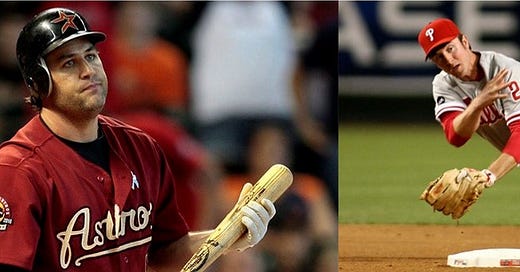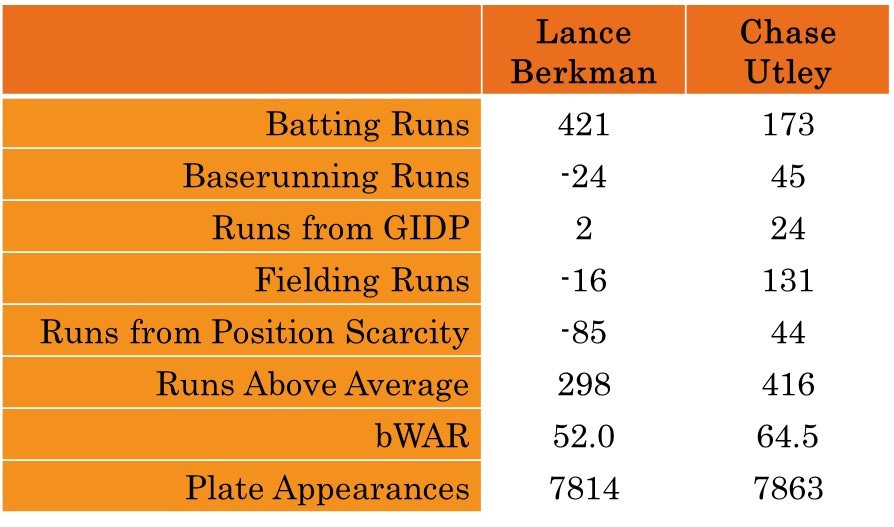Lance Berkman, Chase Utley and the Many Ways to Create Value on a Baseball Field
Lance Berkman has "the numbers" at the plate. But Utley was more valuable on the basepaths, in the field, and through positional scarcity.
My friends were discussing an especially terrible Hall of Fame ballot.1 And it prompted the usual grousing about the voters and their decision-making.
Some were objecting to those who, like the bad voter here, had selected Chase Utley. One responded by texting "Lance Berkman is a HOFer by the numbers. And yet he's not in either."
That text prompted me to look up “the numbers” for both players, and I was fascinated by the comparison. Both were of course valuable baseball players, but they were valuable in different ways. And looking at the difference prompted me to write up this article—the differences are instructive as to how value is created on a baseball field.
Berkman Was Better With a Bat in His Hands
At one level, my friend is right. Berkman has better numbers than Utley…at the plate.
Over his career, Berkman slashed .293/.406/.537 for an OPS of .943. That's 44% percent better than the average major leaguer would have hit in the same parks and years of his career as Berkman.2 Utley slashed .275/.358/.465 for his career, good for an .823 OPS. That’s 17% percent better than the average major leaguer.
And when my friend discussed their “numbers,” I think he is likely referring to their Triple Crown numbers. On on that, Berkman has a clear advantage. You can see his advantage in batting average in the triple slash numbers above—.293 to .275. Berkman also his more home runs than Utley—366 to 259—and drove in more runners—1234 to 1025.
It’s not a small advantage. How big is it? The stat Adjusted Batting Runs takes the value of each player’s offensive contributions and translates it into the number of runs they produced. For his careers, Berkman produced 421 batting runs, an impressive number; it’s 59th best of all time. Utley created 173 batting runs.
So that’s a huge edge in value for Berkman. He created 248 more runs than Utley with his bat over the course of his career.

Utley Was Better At Every Thing Else On a Baseball Field
But hitting isn’t the only thing one can do to create value on a baseball field. A player can create (or take away) value via their baserunning. And here Utley has a clear advantage over Berkman. Baseball Reference also measures “Runs from Baserunning.” Utley has created 45 runs on the basepaths, while Berkman took away 24 runs while running the bases.3
It’s not surprising that Berkman was not a big help on the basepath—one of his nicknames was Fat Elvis. Berkman did steal 86 bases in his career, but was caught 48 times. Utley did not put up big stolen base number—he stole only 154 bases in his career. But Utley’s baserunning advantage comes in other ways. He was only caught 22 times.
As Jay Jaffe wrote in Fangraphs earlier this month, “Among players with at least 150 attempted steals since 1920, his 87.5% success rate ranks first.”
Utley was also excellent at taking the extra base. Here’s Jaffe again: “Additionally, from 2006–12, Utley was annually among the NL’s best in extra bases taken (XT%) — more than one base on a single, more than two on a double — either ranking among the top 10 or with a top-10-worthy percentage but with not enough playing time to qualify due to his injuries.”
Baseball Reference also includes a separate categories the number of runs created by avoiding hitting into double plays. Berkman created 2 runs this way over his career. As a middle of the order hitter, he hit with lots of runners on base. But his ability to hit well and hit the ball in the air kept him from grounding into too may double plays—147 in his career. Utley created 24 runs from avoiding hitting into double plays—he hit into only 93 in his career.
Of course, players can create value while on defense as well. And Utley was an excellent defensive second baseman. Baseball Reference credits him with 131 runs created with his glove. That stat is used to produce Defensive WAR, and Utley is 80th all time in that stat at 17.3
Berkman was a cromulent defender over the course of his career, forced to play more in the outfield than he should have due since he played on teams with Hall of Fame first baseman (Jeff Bagwell early in his career, and Albert Pujols in his 2011 season in St. Louis). Overall, he is credited with -16 defensive runs.4
Position Matters
Finally, it matters where you play on the field. The defensive demands of positions like catcher and shortstop mean that worse hitters can succeed there, while the low defensive demands of positions like first base and designated hitter mean that good offensive players are needed there.
Baseball Reference also lists run value for one’s defensive position. Berkman mostly played the corner outfield spots and first base, which are not that demanding on defense. He is credited with -85 “Runs from Position Scarcity.” Second base—Utley’s main position—is a more demanding defensive position. Utley is credited with 44 “Runs from Position Scarcity.”
Utley Created More Runs Than Berkman In His Career
If you put all this together, Berkman produced 298 runs above average over the course of his career. That’s quite impressive. But Utley produced even more—he’s 416 runs above average. That’s 118 runs more than Bregman.
Utley’s advantage in runs above average produces an advantage in Wins Above Replacement. He created 64.5 wins above replacement in his career. Berkman produced 52.0.
The table below shows all of these numbers so you can compare the value Berkman and Utley created over their careers. I also included their plate appearances because they are so similar—both had equally long careers so this is an even comparison.
What is notable to me about Utley’s overall advantage is that Berkman has such a big advantage at the plate. He created 248 more runs than Utley with his bat. But Utley has advantages in other places—with his legs on the basepaths, with his glove in the field, and with his spot on the defensive spectrum. And those advantages overtake Berkman’s advantages with his bat.
In the end, there are lots of ways to be valuable on a baseball field. The most important one is at the plate—and Berkman created tons of value there. But a player can create value in other ways.
My friend is not wrong that Berkman has Hall of Fame type “numbers” at the plate. But one can see from these numbers how his defense, baserunning, and positional value reduce his value. Berkman received only 4 votes for the Hall of Fame in 2019. That was not enough to stay on the ballot in subsequent years.
And one can see why Utley will receive more than 4 Hall of Fame votes than this year,5 even from those with better standards than the ballot I linked to above.
In the end, there are lots of ways to create value on the baseball field.
Philosophically, it makes sense that if you are small Hall person that Beltre is the only person on the ballot this year who meets those standards. But there is no world where I’m for a small Hall except for Philly guys makes sense.
Those are the calculations that go into the OPS+ statistic.
I cannot find an career ranking for Baserunning Runs on Baseball Reference, but I can find one for the Fangraphs version of Baserunning Runs Above Average. This ranks Utley as the 13th best baserunning of all time at 76.2. For context, Rickey Henderson tops the list (at 144.4) and Lou Brock, who has the second most stolen bases of all time, is just behind Utley at 75.0, 16th best.
Berkman’s defense numbers is especially hurt by that 2011 season when, at age 35, St. Louis signed him to play in the outfield. He recorded -13 Defensive Runs Saved in the outfield that season.
That link goes to the Hall of Fame Vote Tracker, run by Ryan Thibodaux. He and other volunteers find and identify every baseball Hall of Fame voter who publicly lists their ballot. You can see a spreadsheet of their results at that link and follow Thibodaux on Twitter at @NotMrTibbs.






This is a great analysis. One thing though. It seems to me the runs from position scarcity is an iffy stat. Essentially, Utley gets runs simply for being a second baseman while Berman loses runs for bring a right fielder/first baseman. If I understand it correctly, their actual performance or abilities doesn't matter with this number. I know the stat guys use this, but it has always seemed to me to be a questionable part of the defensive stats. Take these out of the picture and both players are just about even in value. Me? I'll take Berkman.
Great peek behind the numbers, Brian! I think Lance is suffering from being in a baseball "small market." Put pinstripes on his exact-same numbers, or land him in Boston or L.A., and he'd be first-ballot! Much like in show biz (or, more particularly, the record biz), it's a lot about PR and ink volume:
If you're constantly on TWIB, your team was clamored for every Game of the Week, the lead on SportsCenter, and Berman made you a funny nickname, your name is front of mind when the writers receive their ballots. I think if one looked at more than a handful of HOF-ers, you'd find plenty whose numbers are far lower/worse than Berkman's, but were on a far more "famous", mid- to large-market team....and yet, there they are!